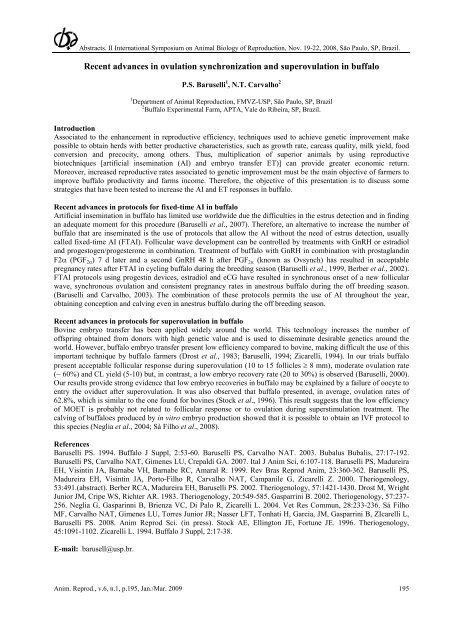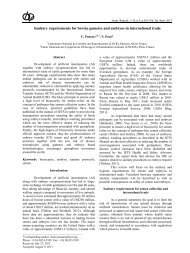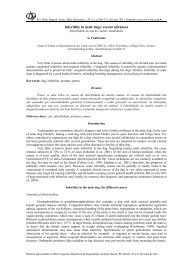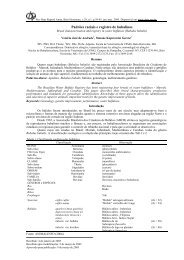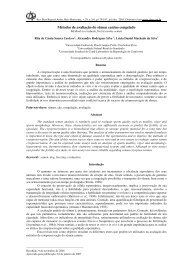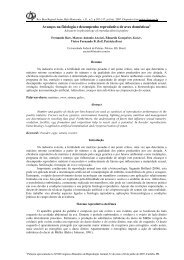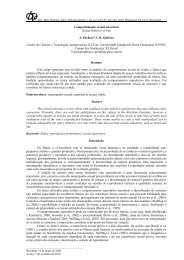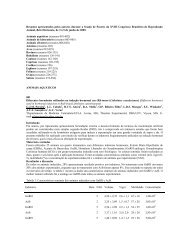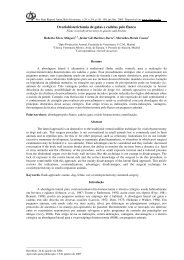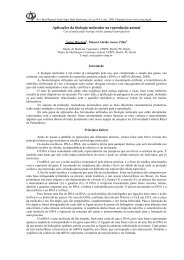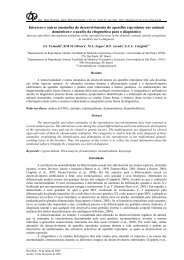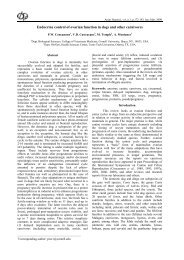Recent advances in ovulation synchronization and superovulation in ...
Recent advances in ovulation synchronization and superovulation in ...
Recent advances in ovulation synchronization and superovulation in ...
You also want an ePaper? Increase the reach of your titles
YUMPU automatically turns print PDFs into web optimized ePapers that Google loves.
Abstracts. II International Symposium on Animal Biology of Reproduction, Nov. 19-22, 2008, São Paulo, SP, Brazil.<br />
<strong>Recent</strong> <strong>advances</strong> <strong>in</strong> <strong>ovulation</strong> <strong>synchronization</strong> <strong>and</strong> super<strong>ovulation</strong> <strong>in</strong> buffalo<br />
P.S. Baruselli 1 , N.T. Carvalho 2<br />
1 Department of Animal Reproduction, FMVZ-USP, São Paulo, SP, Brazil<br />
2 Buffalo Experimental Farm, APTA, Vale do Ribeira, SP, Brazil.<br />
Introduction<br />
Associated to the enhancement <strong>in</strong> reproductive efficiency, techniques used to achieve genetic improvement make<br />
possible to obta<strong>in</strong> herds with better productive characteristics, such as growth rate, carcass quality, milk yield, food<br />
conversion <strong>and</strong> precocity, among others. Thus, multiplication of superior animals by us<strong>in</strong>g reproductive<br />
biotechniques [artificial <strong>in</strong>sem<strong>in</strong>ation (AI) <strong>and</strong> embryo transfer ET)] can provide greater economic return.<br />
Moreover, <strong>in</strong>creased reproductive rates associated to genetic improvement must be the ma<strong>in</strong> objective of farmers to<br />
improve buffalo productivity <strong>and</strong> farms <strong>in</strong>come. Therefore, the objective of this presentation is to discuss some<br />
strategies that have been tested to <strong>in</strong>crease the AI <strong>and</strong> ET responses <strong>in</strong> buffalo.<br />
<strong>Recent</strong> <strong>advances</strong> <strong>in</strong> protocols for fixed-time AI <strong>in</strong> buffalo<br />
Artificial <strong>in</strong>sem<strong>in</strong>ation <strong>in</strong> buffalo has limited use worldwide due the difficulties <strong>in</strong> the estrus detection <strong>and</strong> <strong>in</strong> f<strong>in</strong>d<strong>in</strong>g<br />
an adequate moment for this procedure (Baruselli et al., 2007). Therefore, an alternative to <strong>in</strong>crease the number of<br />
buffalo that are <strong>in</strong>sem<strong>in</strong>ated is the use of protocols that allow the AI without the need of estrus detection, usually<br />
called fixed-time AI (FTAI). Follicular wave development can be controlled by treatments with GnRH or estradiol<br />
<strong>and</strong> progestogen/progesterone <strong>in</strong> comb<strong>in</strong>ation. Treatment of buffalo with GnRH <strong>in</strong> comb<strong>in</strong>ation with prostagl<strong>and</strong><strong>in</strong><br />
F2α (PGF2α) 7 d later <strong>and</strong> a second GnRH 48 h after PGF2α (known as Ovsynch) has resulted <strong>in</strong> acceptable<br />
pregnancy rates after FTAI <strong>in</strong> cycl<strong>in</strong>g buffalo dur<strong>in</strong>g the breed<strong>in</strong>g season (Baruselli et al., 1999, Berber et al., 2002).<br />
FTAI protocols us<strong>in</strong>g progest<strong>in</strong> devices, estradiol <strong>and</strong> eCG have resulted <strong>in</strong> synchronous onset of a new follicular<br />
wave, synchronous <strong>ovulation</strong> <strong>and</strong> consistent pregnancy rates <strong>in</strong> anestrous buffalo dur<strong>in</strong>g the off breed<strong>in</strong>g season.<br />
(Baruselli <strong>and</strong> Carvalho, 2003). The comb<strong>in</strong>ation of these protocols permits the use of AI throughout the year,<br />
obta<strong>in</strong><strong>in</strong>g conception <strong>and</strong> calv<strong>in</strong>g even <strong>in</strong> anestrus buffalo dur<strong>in</strong>g the off breed<strong>in</strong>g season.<br />
<strong>Recent</strong> <strong>advances</strong> <strong>in</strong> protocols for super<strong>ovulation</strong> <strong>in</strong> buffalo<br />
Bov<strong>in</strong>e embryo transfer has been applied widely around the world. This technology <strong>in</strong>creases the number of<br />
offspr<strong>in</strong>g obta<strong>in</strong>ed from donors with high genetic value <strong>and</strong> is used to dissem<strong>in</strong>ate desirable genetics around the<br />
world. However, buffalo embryo transfer present low efficiency compared to bov<strong>in</strong>e, mak<strong>in</strong>g difficult the use of this<br />
important technique by buffalo farmers (Drost et al., 1983; Baruselli, 1994; Zicarelli, 1994). In our trials buffalo<br />
present acceptable follicular response dur<strong>in</strong>g super<strong>ovulation</strong> (10 to 15 follicles ≥ 8 mm), moderate <strong>ovulation</strong> rate<br />
(~ 60%) <strong>and</strong> CL yield (5-10) but, <strong>in</strong> contrast, a low embryo recovery rate (20 to 30%) is observed (Baruselli, 2000).<br />
Our results provide strong evidence that low embryo recoveries <strong>in</strong> buffalo may be expla<strong>in</strong>ed by a failure of oocyte to<br />
entry the oviduct after super<strong>ovulation</strong>. It was also observed that buffalo presented, <strong>in</strong> average, <strong>ovulation</strong> rates of<br />
62.8%, which is similar to the one found for bov<strong>in</strong>es (Stock et al., 1996). This result suggests that the low efficiency<br />
of MOET is probably not related to follicular response or to <strong>ovulation</strong> dur<strong>in</strong>g superstimulation treatment. The<br />
calv<strong>in</strong>g of buffaloes produced by <strong>in</strong> vitro embryo production showed that it is possible to obta<strong>in</strong> an IVF protocol to<br />
this species (Neglia et al., 2004; Sá Filho et al., 2008).<br />
References<br />
Baruselli PS. 1994. Buffalo J Suppl, 2:53-60. Baruselli PS, Carvalho NAT. 2003. Bubalus Bubalis, 27:17-192.<br />
Baruselli PS, Carvalho NAT, Gimenes LU, Crepaldi GA. 2007. Ital J Anim Sci, 6:107-118. Baruselli PS, Madureira<br />
EH, Vis<strong>in</strong>t<strong>in</strong> JA, Barnabe VH, Barnabe RC, Amaral R. 1999. Rev Bras Reprod Anim, 23:360-362. Baruselli PS,<br />
Madureira EH, Vis<strong>in</strong>t<strong>in</strong> JA, Porto-Filho R, Carvalho NAT, Campanile G, Zicarelli Z. 2000. Theriogenology,<br />
53:491.(abstract). Berber RCA, Madureira EH, Baruselli PS. 2002. Theriogenology, 57:1421-1430. Drost M, Wright<br />
Junior JM, Cripe WS, Richter AR. 1983. Theriogenology, 20:549-585. Gasparr<strong>in</strong>i B. 2002. Theriogenology, 57:237-<br />
256. Neglia G, Gaspar<strong>in</strong>ni B, Brienza VC, Di Palo R, Zicarelli L. 2004. Vet Res Commun, 28:233-236. Sá Filho<br />
MF, Carvalho NAT, Gimenes LU, Torres Junior JR; Nasser LFT, Tonhati H, Garcia, JM, Gasparr<strong>in</strong>i B, ZIcarelli L,<br />
Baruselli PS. 2008. Anim Reprod Sci. (<strong>in</strong> press). Stock AE, Ell<strong>in</strong>gton JE, Fortune JE. 1996. Theriogenology,<br />
45:1091-1102. Zicarelli L. 1994. Buffalo J Suppl, 2:17-38.<br />
E-mail: barusell@usp.br.<br />
Anim. Reprod., v.6, n.1, p.195, Jan./Mar. 2009 195


